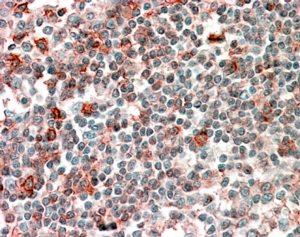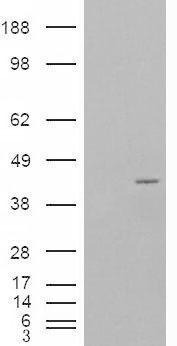Goat Anti-NCF4 / P40PHOX Antibody
Peptide-affinity purified goat antibody
- SPECIFICATION
- CITATIONS
- PROTOCOLS
- BACKGROUND

Application
| WB, IHC, E |
|---|---|
| Primary Accession | Q15080 |
| Other Accession | NP_038202, 4689 |
| Reactivity | Human |
| Predicted | Dog |
| Host | Goat |
| Clonality | Polyclonal |
| Concentration | 100ug/200ul |
| Isotype | IgG |
| Calculated MW | 39032 Da |
| Gene ID | 4689 |
|---|---|
| Other Names | Neutrophil cytosol factor 4, NCF-4, Neutrophil NADPH oxidase factor 4, SH3 and PX domain-containing protein 4, p40-phox, p40phox, NCF4, SH3PXD4 |
| Dilution | WB~~1:1000 IHC~~1:100~500 E~~N/A |
| Format | 0.5 mg IgG/ml in Tris saline (20mM Tris pH7.3, 150mM NaCl), 0.02% sodium azide, with 0.5% bovine serum albumin |
| Storage | Maintain refrigerated at 2-8°C for up to 6 months. For long term storage store at -20°C in small aliquots to prevent freeze-thaw cycles. |
| Precautions | Goat Anti-NCF4 / P40PHOX Antibody is for research use only and not for use in diagnostic or therapeutic procedures. |
| Name | NCF4 (HGNC:7662) |
|---|---|
| Synonyms | SH3PXD4 |
| Function | Subunit of the phagocyte NADPH oxidase complex that mediates the transfer of electrons from cytosolic NADPH to O2 to produce the superoxide anion (O2(-)) (Probable). In the activated complex, electrons are first transferred from NADPH to flavin adenine dinucleotide (FAD) and subsequently transferred via two heme molecules to molecular oxygen, producing superoxide through an outer-sphere reaction (By similarity). Activation of the NADPH oxidase complex is initiated by the assembly of cytosolic subunits of the NADPH oxidase complex with the core NADPH oxidase complex to form a complex at the plasma membrane or phagosomal membrane (By similarity). This activation process is initiated by phosphorylation dependent binding of the cytosolic NCF1/p47-phox subunit to the C-terminus of CYBA/p22-phox (By similarity). |
| Cellular Location | Cytoplasm, cytosol. Endosome membrane; Peripheral membrane protein; Cytoplasmic side. Membrane; Peripheral membrane protein. Note=Translocates to the membrane upon activation by phorbol myristate acetate (PMA) |
| Tissue Location | Expression is restricted to hematopoietic cells. |

Thousands of laboratories across the world have published research that depended on the performance of antibodies from Abcepta to advance their research. Check out links to articles that cite our products in major peer-reviewed journals, organized by research category.
info@abcepta.com, and receive a free "I Love Antibodies" mug.
Provided below are standard protocols that you may find useful for product applications.
Background
The protein encoded by this gene is a cytosolic regulatory component of the superoxide-producing phagocyte NADPH-oxidase, a multicomponent enzyme system important for host defense. This protein is preferentially expressed in cells of myeloid lineage. It interacts primarily with neutrophil cytosolic factor 2 (NCF2/p67-phox) to form a complex with neutrophil cytosolic factor 1 (NCF1/p47-phox), which further interacts with the small G protein RAC1 and translocates to the membrane upon cell stimulation. This complex then activates flavocytochrome b, the membrane-integrated catalytic core of the enzyme system. The PX domain of this protein can bind phospholipid products of the PI(3) kinase, which suggests its role in PI(3) kinase-mediated signaling events. The phosphorylation of this protein was found to negatively regulate the enzyme activity. Alternatively spliced transcript variants encoding distinct isoforms have been observed.
References
Variation at the NFATC2 Locus Increases the Risk of Thiazolinedinedione-Induced Edema in the Diabetes REduction Assessment with ramipril and rosiglitazone Medication (DREAM) Study. Bailey SD, et al. Diabetes Care, 2010 Jul 13. PMID 20628086.
Polymorphisms in innate immunity genes and risk of childhood leukemia. Han S, et al. Hum Immunol, 2010 Jul. PMID 20438785.
Risk of meningioma and common variation in genes related to innate immunity. Rajaraman P, et al. Cancer Epidemiol Biomarkers Prev, 2010 May. PMID 20406964.
Hematologically important mutations: the autosomal recessive forms of chronic granulomatous disease (second update). Roos D, et al. Blood Cells Mol Dis, 2010 Apr 15. PMID 20167518.
Polymorphisms in innate immunity genes and patients response to dendritic cell-based HIV immuno-treatment. Segat L, et al. Vaccine, 2010 Mar 2. PMID 20056178.
If you have used an Abcepta product and would like to share how it has performed, please click on the "Submit Review" button and provide the requested information. Our staff will examine and post your review and contact you if needed.
If you have any additional inquiries please email technical services at tech@abcepta.com.













 Foundational characteristics of cancer include proliferation, angiogenesis, migration, evasion of apoptosis, and cellular immortality. Find key markers for these cellular processes and antibodies to detect them.
Foundational characteristics of cancer include proliferation, angiogenesis, migration, evasion of apoptosis, and cellular immortality. Find key markers for these cellular processes and antibodies to detect them. The SUMOplot™ Analysis Program predicts and scores sumoylation sites in your protein. SUMOylation is a post-translational modification involved in various cellular processes, such as nuclear-cytosolic transport, transcriptional regulation, apoptosis, protein stability, response to stress, and progression through the cell cycle.
The SUMOplot™ Analysis Program predicts and scores sumoylation sites in your protein. SUMOylation is a post-translational modification involved in various cellular processes, such as nuclear-cytosolic transport, transcriptional regulation, apoptosis, protein stability, response to stress, and progression through the cell cycle. The Autophagy Receptor Motif Plotter predicts and scores autophagy receptor binding sites in your protein. Identifying proteins connected to this pathway is critical to understanding the role of autophagy in physiological as well as pathological processes such as development, differentiation, neurodegenerative diseases, stress, infection, and cancer.
The Autophagy Receptor Motif Plotter predicts and scores autophagy receptor binding sites in your protein. Identifying proteins connected to this pathway is critical to understanding the role of autophagy in physiological as well as pathological processes such as development, differentiation, neurodegenerative diseases, stress, infection, and cancer.




